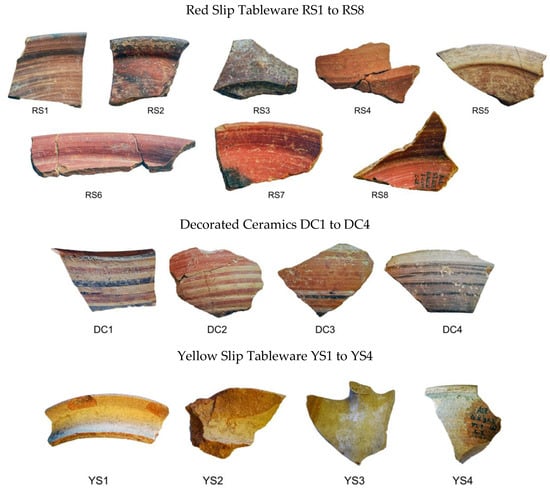Journal Description
Colorants
Colorants
is an international, peer-reviewed, open access journal on all aspects of coloring matters published quarterly online by MDPI.
- Open Access— free for readers, with article processing charges (APC) paid by authors or their institutions.
- Rapid Publication: manuscripts are peer-reviewed and a first decision is provided to authors approximately 27.8 days after submission; acceptance to publication is undertaken in 8.9 days (median values for papers published in this journal in the second half of 2023).
- Recognition of Reviewers: APC discount vouchers, optional signed peer review, and reviewer names published annually in the journal.
Latest Articles
An Archaeometric Study of the Iron Age Ceramics from Quinta do Almaraz Archaeologic Site (8th to 5th Centuries BC)—Colour and Mineralogical Characterization
Colorants 2024, 3(2), 111-124; https://doi.org/10.3390/colorants3020008 (registering DOI) - 25 Apr 2024
Abstract
►
Show Figures
The ceramic pastes of ca. 31 samples recovered from the Almaraz archaeological site, located in the south bench of Tagus River, were studied in detail using XRF, micro-Raman and GSDR spectroscopies, as well as the XRD technique. The ceramic sherds could be grouped
[...] Read more.
The ceramic pastes of ca. 31 samples recovered from the Almaraz archaeological site, located in the south bench of Tagus River, were studied in detail using XRF, micro-Raman and GSDR spectroscopies, as well as the XRD technique. The ceramic sherds could be grouped into six categories, red slip tableware, decorated tableware, yellow slip tableware, grey tableware, common tableware, and handmade pottery. Our studies of the mineralogic composition of the sherds’ body indicate all ceramics were produced locally, using siliceous clays in most cases and calcareous clays in a few ones. Micro-Raman and ground state diffuse reflectance absorption spectroscopy provided useful information regarding the materials used to produce the coloured ceramics: hematite and brookite for the red slip and decorated ceramics, jacobsite or carbon black for the black decoration or grey ceramics. For the yellow slip tableware, a simple engobe rich in yellow clay was used. XRF spectroscopic studies provided the elemental composition of all samples, and biplots of the potassium (K) versus calcium (Ca) contents, normalized to the silicon content of each ceramic paste, clearly show Pliocene and Miocene local clays sources were used to produce most ceramics. Only one sherd can be considered a Lisbon production.
Full article
Open AccessArticle
Solid-State Luminescence with a Large Stokes Shift in Starch Functionalized with Low-Content ESIPT Dye
by
Emerson Colonetti, Lilian C. da Luz and Fabiano S. Rodembusch
Colorants 2024, 3(2), 99-110; https://doi.org/10.3390/colorants3020007 - 03 Apr 2024
Abstract
Herein, we present the preparation of solid-state photoactive starches with a large Stokes shift, along with the resulting materials. In this investigation, 2-(2′-hydroxyphenyl)benzazole derivatives responsive to intramolecular proton transfer in the excited state (ESIPT) were covalently bonded to the polymeric structure of starch
[...] Read more.
Herein, we present the preparation of solid-state photoactive starches with a large Stokes shift, along with the resulting materials. In this investigation, 2-(2′-hydroxyphenyl)benzazole derivatives responsive to intramolecular proton transfer in the excited state (ESIPT) were covalently bonded to the polymeric structure of starch through a reaction involving an isothiocyanate group and the hydroxyl groups of starch. These compounds exhibit absorption at approximately 350 nm, which is related to fully spin- and symmetry-allowed π → π* electronic transitions, and solid-state fluorescence at approximately 500 nm, which features a significant separation between the absorption and emission maxima (~9000 cm−1). Due to the minimal use of fluorophores in functionalized starch preparation, this modification does not affect the original properties of the starch. Finally, photoactive starch-based films with significantly high transparency were successfully produced.
Full article
(This article belongs to the Special Issue Feature Papers in Colorant Chemistry)
►▼
Show Figures

Graphical abstract
Open AccessArticle
Optical Investigation of 2-amino-7-isocyanofluorene, a Novel Blue-Emitting Solvatochromic Dye
by
Bence Kontra, Zoltán Mucsi, László Vanyorek and Miklós Nagy
Colorants 2024, 3(2), 86-98; https://doi.org/10.3390/colorants3020006 - 25 Mar 2024
Abstract
►▼
Show Figures
Smart solvatochromic isocyano-aminoarenes (ICAArs) have been gaining attention owing to their unique photophysical, antifungal and anticancer properties. Using a simple dehydration reaction with in situ-generated dichlorocarbene, we prepared 2-amino-7-isocyanofluorene (2,7-ICAF). We studied the effect of the longer polarization axis provided by the fluorene
[...] Read more.
Smart solvatochromic isocyano-aminoarenes (ICAArs) have been gaining attention owing to their unique photophysical, antifungal and anticancer properties. Using a simple dehydration reaction with in situ-generated dichlorocarbene, we prepared 2-amino-7-isocyanofluorene (2,7-ICAF). We studied the effect of the longer polarization axis provided by the fluorene core on the spectral properties and we also compared it to those of the starting diamine. 2,7-ICAF shows a clear solvatochromic behavior close to the blue part (370–420 nm) of the visible spectrum. Quantum chemical calculations show internal charge transfer (ICT) between the donor amino and the electron-withdrawing isocyano groups. 2,7-ICAF has high molar absorptivity (ε = 15–18·103 M−1cm−1) and excellent quantum yield (Φf = 70–95%) in most solvents; however, its fluorescence is completely quenched in water. The high brightness (ε·Φf) and close to zero quantum yield in water may be favorable in biolabeling applications, where background fluorescence should be kept minimal. Overall, 2,7-ICAF shows enhanced photophysical properties compared to its previously investigated relative 4-amino-4′-isocyano-1,1′-biphenyl (4,4′-ICAB).
Full article

Figure 1
Open AccessArticle
Decolorization and Detoxification of Industrial Wastewater Containing Indigo Carmine by Aspergillus niger AN400 in Sequential Reactors
by
Kelly Rodrigues, Alana M. X. de Sousa, Andreza D. O. dos Santos, Bárbara C. A. Barbosa, A. Rita Silva, Luciana Pereira and Glória M. M. Silva
Colorants 2024, 3(1), 73-85; https://doi.org/10.3390/colorants3010005 - 04 Mar 2024
Abstract
►▼
Show Figures
Effluents from the textile industry are an active problem in the sector and one of the world’s main environmental problems. The conventional treatments applied are not always efficient in terms of compliance with legislation, and, in many cases, the efficiency of treatment is
[...] Read more.
Effluents from the textile industry are an active problem in the sector and one of the world’s main environmental problems. The conventional treatments applied are not always efficient in terms of compliance with legislation, and, in many cases, the efficiency of treatment is guaranteed by the enormous energy expenditure involved, camouflaging the momentary problem and not effectively treating it. In this work, batch reactors with immobilized biomass of Aspergillus niger AN400 were arranged in series for the treatment of real textile wastewater containing approximately 20 mg/L of indigo carmine. Sucrose was added as a co-substrate in concentrations of 1 g/L and 0.5 g/L, in the first and second reactors, respectively, over 19 cycles of 48 h. The highest decolorization rate in the system was (93 ± 4) %, with the largest amount removed in the first reactor (90 ± 6) %, occurring mainly by biological means. The production of aromatic by-products from the initial degradation of the dye molecule was reflected in the lower removal efficiency of dissolved organic matter: 52% in the first reactor, and 25% in the second reactor. The number of colonies of fungi was higher than that of bacteria, 2.24:1 and 2.44:1 in the first and second reactors, respectively. The treated effluent in the system showed less toxicity than the raw effluent, and this demonstrates the potential of this technology in the treatment of textile effluents containing indigo carmine.
Full article

Figure 1
Open AccessReview
Azobenzene-Containing Schiff-Bases—Syntheses and Dyes Applications
by
Estelle Leonard, China Takeda and Takashiro Akitsu
Colorants 2024, 3(1), 53-72; https://doi.org/10.3390/colorants3010004 - 09 Feb 2024
Abstract
►▼
Show Figures
Azo-Schiff bases contain an azo photochrome showing isomerization accompanying with color change, and an imine moiety (which can contribute to the metal complexation capability). The syntheses of these molecules will be described, and their dyes applications will be discussed, such as for fuel
[...] Read more.
Azo-Schiff bases contain an azo photochrome showing isomerization accompanying with color change, and an imine moiety (which can contribute to the metal complexation capability). The syntheses of these molecules will be described, and their dyes applications will be discussed, such as for fuel cells, as photometric or colorimetric sensors. In addition, liquid crystals and their antibacterial efficiencies will also be discussed.
Full article
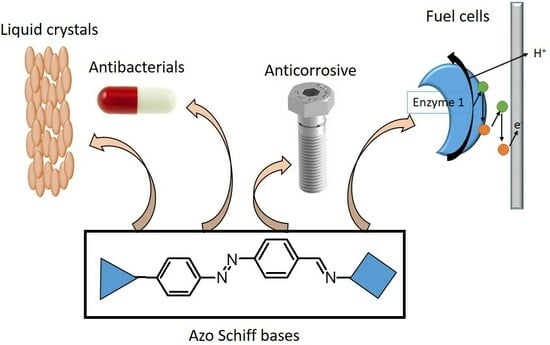
Graphical abstract
Open AccessArticle
Development of a Carotenoid-Rich Microalgae Colorant by Microencapsulation
by
Ana N. Nunes, Joana Monte, Soraya Rodríguez-Rojo, Isabel D. Nogueira, Luís F. Gouveia, Carla Brazinha and Ana A. Matias
Colorants 2024, 3(1), 39-52; https://doi.org/10.3390/colorants3010003 - 12 Jan 2024
Abstract
►▼
Show Figures
Dunaliella salina has been recognized as an excellent biomass source of carotenoid, which can be used as a natural orange coloring agent for food products. The most eco-friendly approach for extracting carotenoid is through supercritical carbon dioxide extraction, as it yields highly concentrated
[...] Read more.
Dunaliella salina has been recognized as an excellent biomass source of carotenoid, which can be used as a natural orange coloring agent for food products. The most eco-friendly approach for extracting carotenoid is through supercritical carbon dioxide extraction, as it yields highly concentrated extracts while preventing pigment thermal degradation. However, there are limitations when a lipophilic extract is considered a food ingredient, in particular very difficult handling and low solubility in water-based products. The aim of this study was to develop a hydrosoluble form of a natural carotenoid-rich extract recovered from algae biomass within a biorefinery concept to be incorporated in aqueous-based food products. A two-step process was developed, starting with the emulsification of the supercritical extract into a mixture of maltodextrin and gum arabic, using soy lecithin as an emulsifier. The emulsification was followed by a spray-drying step. The impact of process variables on the encapsulation yield, efficiency, emulsion properties, and particle characteristics was studied. The resulting particles exhibited an intense orange color and good water dispersibility, facilitating uniform yellow coloring when incorporated into an aqueous-based product. Overall, spray-drying emulsions containing carotenoids derived from Dunaliella salina prove to be a promising strategy for the global market demand for natural colorants.
Full article
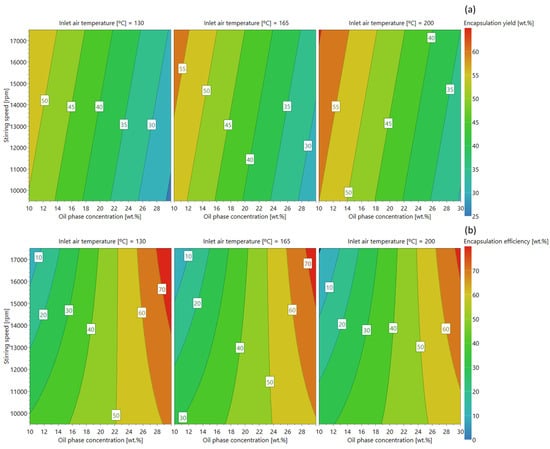
Figure 1
Open AccessArticle
A Study on the Structure, Optical Properties and Cellular Localization of Novel 1,3-Benzothiazole-Substituted BODIPYs
by
Olga Kirkilessi, Christina Arapatzi, Heribert Reis, Vassiliki Kostourou, Kyriakos C. Prousis and Theodora Calogeropoulou
Colorants 2024, 3(1), 17-38; https://doi.org/10.3390/colorants3010002 - 31 Dec 2023
Abstract
A library of seven novel 1,3-benzothiazole-substituted BODIPY derivatives with tunable optical properties was synthesized. The new fluorescent dyes exhibited bathochromically shifted absorptions (up to 670 nm) and emissions centered in the red and near-infrared spectral region (up to 677 nm) in comparison to
[...] Read more.
A library of seven novel 1,3-benzothiazole-substituted BODIPY derivatives with tunable optical properties was synthesized. The new fluorescent dyes exhibited bathochromically shifted absorptions (up to 670 nm) and emissions centered in the red and near-infrared spectral region (up to 677 nm) in comparison to the parent compound 8-phenyl BODIPY (λabs: 499 nm, λemi: 508 nm). (TD)DFT calculations were performed to rationalize the spectroscopic properties of the new dyes. The cellular biodistribution of the new BODIPY dyes, their fluorescence stability and toxicity were investigated in both living and fixed fibroblasts using time-lapse fluorescent imaging and confocal microscopy. Six of the seven new dyes were photostable and non-toxic in vitro at 10 μM concentration. In addition, they efficiently stained the cell membrane, showing diffuse and dotty localization within the cell at low concentrations (1.0 and 0.1 μM). Specifically, dye TC498 was localized in vesicular structures in both live and fixed cells and could be used as a suitable marker in co-staining studies with other commonly used fluorescent probes.
Full article
(This article belongs to the Special Issue Luminescent Small Molecules for Biochemistry)
►▼
Show Figures
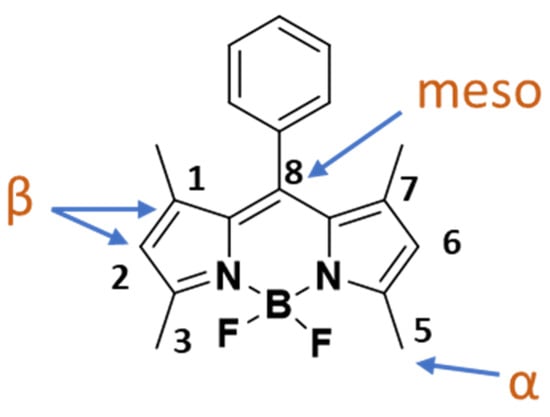
Figure 1
Open AccessReview
Bimetallic Fenton-like Catalysts in the Remediation of Dyes
by
Lydia R. Milam and Roy P. Planalp
Colorants 2024, 3(1), 1-16; https://doi.org/10.3390/colorants3010001 - 21 Dec 2023
Abstract
Remediation of organic dyes in natural waters is a significant environmental need under active study. This review analyzes bimetallic catalytic degradation systems that are based on the Fenton chemistry concept and that generate reactive oxygen species (ROS) as the agent of dye breakdown.
[...] Read more.
Remediation of organic dyes in natural waters is a significant environmental need under active study. This review analyzes bimetallic catalytic degradation systems that are based on the Fenton chemistry concept and that generate reactive oxygen species (ROS) as the agent of dye breakdown. Recently developed advanced oxidation processes (AOPs) take advantage of bimetallic heterogeneous catalysts to facilitate rapid rates and full degradation. Catalysts based on two metals including iron, copper, molybdenum, cobalt and magnesium are discussed mechanistically as examples of effective radical ROS producers. The reactive oxygen species hydroxyl radical, superoxide radical, sulfate radical and singlet oxygen are discussed. System conditions for the best degradation are compared, with implementation techniques mentioned. The outlook for further studies of dye degradation is presented.
Full article
(This article belongs to the Special Issue Feature Papers in Colorant Chemistry)
►▼
Show Figures

Figure 1
Open AccessArticle
Synthesis of High Near-Infrared Reflective Black Pigment Based on YMn2O5
by
Kazuki Yamaguchi, Satoru Mochizuki, Yudai Nagato, Takuro Morimoto and Toshiyuki Masui
Colorants 2023, 2(4), 705-715; https://doi.org/10.3390/colorants2040036 - 06 Dec 2023
Abstract
Y(Mn0.95M0.05)2O5 (M = Al, Fe, Ga, Ti, and Zr) samples were synthesized via a sol–gel method using citric acid to find a new near-infrared (NIR) reflective black pigment. Among these samples, the optical reflectance of Y(Mn
[...] Read more.
Y(Mn0.95M0.05)2O5 (M = Al, Fe, Ga, Ti, and Zr) samples were synthesized via a sol–gel method using citric acid to find a new near-infrared (NIR) reflective black pigment. Among these samples, the optical reflectance of Y(Mn0.95Fe0.05)2O5 and Y(Mn0.95Ga0.05)2O5 in the near-infrared region was found to be larger than that of YMn2O5. Then, the concentration of the dopant (Fe or Ga) was changed between 0 and 15%, and the resulting UV–Vis–NIR reflectance spectra were measured. As a result, the optical reflectance of the Fe-doped samples decreased in the near-infrared region, while that of the Ga-doped samples increased. Accordingly, Y(Mn1−xGax)2O5 (0 ≤ x ≤ 0.20) samples were synthesized, and the crystal structure, particle size, optical properties, and color of the samples were characterized. The single-phase samples were obtained in the composition range of 0 ≤ x ≤ 0.15, and the lattice volume decreased with increasing Ga3+ concentration. Optical absorption below 850 nm was attributed to the charge transfer transition between O2p and Mn3d orbitals, and the absorption wavelength of Y(Mn1−xGax)2O5 shifted to the shorter wavelength side as the Ga3+ content increased, because of the decrease in the Mn3+ concentration. Although the sample color became slightly reddish black by the Ga3+ doping, the solar reflectance in the near-infrared region reached 47.6% at the composition of Y(Mn0.85Ga0.15)2O5. Furthermore, this NIR reflectance value was higher than those of the commercially available products (R < 45%).
Full article
(This article belongs to the Special Issue Feature Papers in Colorant Chemistry)
►▼
Show Figures
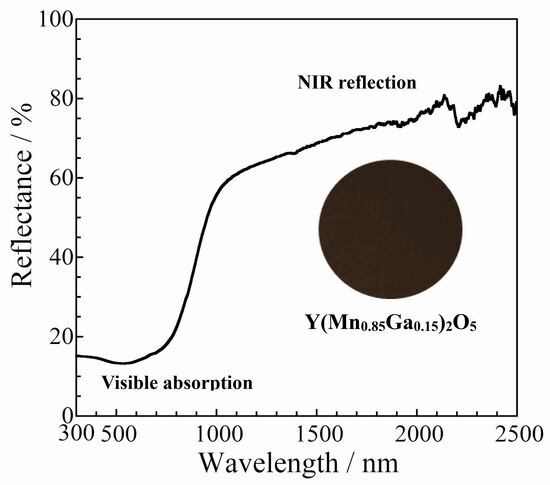
Graphical abstract
Open AccessReview
Revolutionizing Wastewater Treatment: Harnessing Metal–Organic Frameworks for Exceptional Photocatalytic Degradation of Azo-Type Dyes
by
Jose Manuel Barrera-Andrade, Natali de la Fuente-Maldonado, Ricardo Lopez-Medina, Ana Marisela Maubert-Franco and Elizabeth Rojas-Garcia
Colorants 2023, 2(4), 674-704; https://doi.org/10.3390/colorants2040035 - 13 Nov 2023
Abstract
►▼
Show Figures
Due to the high stability of azo-type dyes, conventional treatment processes such as adsorption, flocculation, and activated sludge are not efficient for decolorizing wastewater effluents. An alternative to traditional wastewater treatment is photocatalysis, which has gained significant interest because research has shown it
[...] Read more.
Due to the high stability of azo-type dyes, conventional treatment processes such as adsorption, flocculation, and activated sludge are not efficient for decolorizing wastewater effluents. An alternative to traditional wastewater treatment is photocatalysis, which has gained significant interest because research has shown it to be a viable and cost-effective process that uses sunlight as an inexhaustible energy source. In heterogeneous photocatalysis, a photocatalyst is required, such as TiO2, ZnO, composite materials, and, more recently, metal–organic frameworks (MOFs). MOFs, also known as “coordination polymers”, exhibit photocatalytic properties and have been proven to be promising materials in the photocatalytic degradation of dyes. This study presents recent advances in using MOFs as photocatalysts to degrade recalcitrant contaminants like azo-type dyes. Recent advancements in developing photocatalysts based on MOFs are focused on two strategies. Firstly, the development of new MOFs composed of complex ligands or a mixed ligand system, and secondly, the synthesis of composite materials based on MOFs and metal oxides, metals, sulfides, nitrides, etc. Both strategies have significantly contributed to the search for new semiconductors to degrade some recalcitrate contaminants in wastewater.
Full article

Figure 1
Open AccessArticle
Squaric Acid Core Substituted Unsymmetrical Squaraine Dyes for Dye-Sensitized Solar Cells: Effect of Electron Acceptors on Their Photovoltaic Performance
by
Safalmani Pradhan, Yuki Kurokawa, Suraya Shaban and Shyam S. Pandey
Colorants 2023, 2(4), 654-673; https://doi.org/10.3390/colorants2040034 - 06 Nov 2023
Cited by 2
Abstract
The design and development of sensitizing dyes possessing wide-wavelength photon harvesting encompassing visible to near-infrared (NIR) wavelength regions are unavoidable for increasing the overall efficiency of dye-sensitized solar cells (DSSCs). In this study, three far-red-sensitive squaraine sensitizers were designed computationally, synthesized, and characterized,
[...] Read more.
The design and development of sensitizing dyes possessing wide-wavelength photon harvesting encompassing visible to near-infrared (NIR) wavelength regions are unavoidable for increasing the overall efficiency of dye-sensitized solar cells (DSSCs). In this study, three far-red-sensitive squaraine sensitizers were designed computationally, synthesized, and characterized, aiming towards their suitability as a potential sensitizer for DSSCs. It has been found that the incorporation of an electron acceptor moiety in the central squaraine core brought about a red shift in the absorption maximum (λmax) and the emergence of a secondary absorption band in the blue region, thus broadening the photon-harvesting window. In addition, it also lowered the dye’s HOMO energy level enabling a facile regeneration of the photo-excited dye, which improved the photovoltaic performance of SQ-223, exhibiting a photoconversion efficiency (PCE) of 4.67%. Thereafter, to address the issue of wide-wavelength photon harvesting, DSSCs were fabricated by co-adsorbing two complementary dyes SQ-223 and D-131 in various molar ratios. The DSSC fabricated with D-131 and SQ-223 in 9:1 molar ratio displayed the best photovoltaic performance with a PCE of 5.81%, a significantly higher PCE when compared to corresponding individual dye-based DSSCs containing D-131 (3.94%) and SQ-223 (4.67%).
Full article
(This article belongs to the Special Issue Recent Progress on Functional Dyes and Their Applications)
►▼
Show Figures
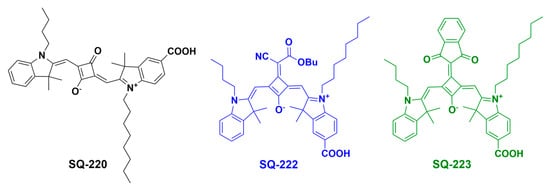
Figure 1
Open AccessArticle
Printing with tonalli: Reproducing Featherwork from Precolonial Mexico Using Structural Colorants
by
Abigail Trujillo-Vazquez, Fereshteh Abedini, Alina Pranovich, Carinna Parraman and Susanne Klein
Colorants 2023, 2(4), 632-653; https://doi.org/10.3390/colorants2040033 - 29 Oct 2023
Abstract
Two of the most significant cases of extant 16th-century featherwork from Mexico are the so-called Moctezuma’s headdress and the Ahuizotl shield. While the feathers used in these artworks exhibit lightfast colors, their assembly comprises mainly organic materials, which makes them extremely fragile. Printed
[...] Read more.
Two of the most significant cases of extant 16th-century featherwork from Mexico are the so-called Moctezuma’s headdress and the Ahuizotl shield. While the feathers used in these artworks exhibit lightfast colors, their assembly comprises mainly organic materials, which makes them extremely fragile. Printed media, including books, catalogs, educational materials, and fine copies, offer an accessible means for audiences to document and disseminate visual aspects of delicate cultural artifacts without risking their integrity. Nevertheless, the singular brightness and iridescent colors of feathers are difficult to communicate to the viewer in printed reproductions when traditional pigments are used. This research explores the use of effect pigments (multilayered reflective structures) and improved halftoning techniques for additive printing, with the objective of enhancing the reproduction of featherwork by capturing its changing color and improving texture representation via a screen printing process. The reproduced images of featherwork exhibit significant perceptual resemblances to the originals, primarily owing to the shared presence of structural coloration. We applied structure-aware halftoning to better represent the textural qualities of feathers without compromising the performance of effect pigments in the screen printing method. Our prints show angle-dependent color, although their gamut is reduced. The novelty of this work lies in the refinement of techniques for printing full-color images by additive printing, which can enhance the 2D representation of the appearance of culturally significant artifacts.
Full article
(This article belongs to the Special Issue Traversing the History of Humanity Through the Study of the Artists' Pigments: From the Lascaux Cave Paintings to Modern Art)
►▼
Show Figures

Figure 1
Open AccessArticle
Evaluation of Solar Conversion Efficiency in Dye-sensitized Solar Cells Using Natural Dyes Extracted from Alpinia purpurata and Alstroemeria Flower Petals as Novel Photosensitizers
by
Leonardo Ricardo Bernardes da Conceição, Higor Oliveira da Cunha, Arcano Matheus Bragança Leite, Rajendran Suresh Babu, Sebastian Raja, Caue Ribeiro and Ana Lucia Ferreira de Barros
Colorants 2023, 2(4), 618-631; https://doi.org/10.3390/colorants2040032 - 10 Oct 2023
Cited by 6
Abstract
Herein, we evaluate the conversion efficiency of dye-sensitized solar cells (DSSCs) photosensitized using two different natural dyes extracted from Alpinia purpurata and Alstroemeria flower petals. The appreciable absorption capacity of the extracts in the visible light region was examined through absorption spectroscopy. The
[...] Read more.
Herein, we evaluate the conversion efficiency of dye-sensitized solar cells (DSSCs) photosensitized using two different natural dyes extracted from Alpinia purpurata and Alstroemeria flower petals. The appreciable absorption capacity of the extracts in the visible light region was examined through absorption spectroscopy. The functional groups of the corresponding pigments were identified through Fourier transform spectroscopy (FTIR) technique thus indicating the presence of cyanidin 3-glycosides and piperine in the flowers of Alstroemeria and Alpinia purpurata. The extracted dyes were immobilized on TiO2 on transparent conducting FTO glass, which were used as photoanode. The dye-coated TiO2 photoanode, pt photocathode and iodide/triiodide redox electrolyte assembled into a cell module was illuminated by a light source intensity 100 mW/cm2 to measure the photovoltaic conversion efficiency of DSSCs. The TiO2 anode and Pt counter electrode surface roughness and morphological studies were evaluated using atomic force microscope (AFM) and field emission scanning electron microscopy (FESEM), respectively. Through the photoelectric characterizations, it was promising to verify that the solar conversion efficiency was calculated with the photovoltaic cell sensitized by Alstroemeria and Alpinia purpurata. This was achieved with a yield (η) of 1.74% and 0.65%, with an open-circuit voltage (Voc) of 0.39 and 0.53 V, short-circuit current density (Jsc) of 2.04 and 0.49 mA/cm2, fill factor (FF) of 0.35 and 0.40, and Pmax of 0.280 and 0.100 mW/cm2, respectively. The results are promising and demonstrate the importance of the search for new natural dyes to be used in organic solar cells for the development of devices that generate electricity in a sustainable way.
Full article
(This article belongs to the Special Issue Recent Progress on Functional Dyes and Their Applications)
►▼
Show Figures
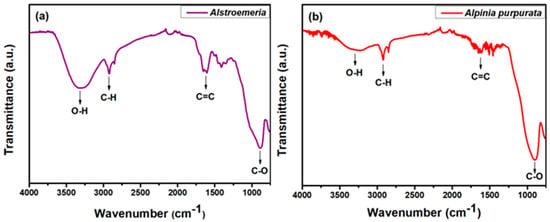
Figure 1
Open AccessArticle
What’s the Madder? Characterization of Old Fashioned Alizarin/Aluminum Red Pigments Using Liquid and Solid-State NMR
by
Leonel C. Silva, Vanessa Otero, Maria J. Melo, Eurico J. Cabrita and Luís Mafra
Colorants 2023, 2(4), 601-617; https://doi.org/10.3390/colorants2040031 - 30 Sep 2023
Abstract
This work provides significant insight into the molecular structure of alizarin lake pigments used by artists in the past. To characterize two red powders, lakes 1 and 2, obtained by complexation of 1,2-dihydroxy anthraquinone (alizarin) with Al3+, a multi-analytical approach
[...] Read more.
This work provides significant insight into the molecular structure of alizarin lake pigments used by artists in the past. To characterize two red powders, lakes 1 and 2, obtained by complexation of 1,2-dihydroxy anthraquinone (alizarin) with Al3+, a multi-analytical approach was designed based on solid and liquid state Nuclear Magnetic Resonance Spectroscopy (NMR), Fourier-Transform Infrared Spectroscopy (FTIR), Mass Spectrometry (MS) and Density Functional Theory (DFT) calculations. Lake 1 was synthesized according to literature and compared with lake 2, a reproduction of an artist’s pigment. FTIR showed Al3+ coordinated to oxygens in C1 and C9, and that in lake 2 the -OH groups in C2 are protonated, being responsible for its low solubility. 1H-NMR proved that lake 2 is formed by two tautomers [Al(Aliz-2-H-)2(OH)(H2O)] and [Al(Aliz-10-H-)2(OH)(H2O)], the latter being the major species. SS-NMR was the only technique that got insight into the Al3+ coordination, octahedral for both lakes. It confirmed the existence of two species in lake 2, in a 5:1 ratio. Both are amorphous “open structures”, resulting in fewer constraints for the ligands and in a large variety of geometries. SS-NMR allowed the analysis of the red pigments without preparation, which is a unique advantage for their study in artworks.
Full article
(This article belongs to the Special Issue Traversing the History of Humanity Through the Study of the Artists' Pigments: From the Lascaux Cave Paintings to Modern Art)
►▼
Show Figures
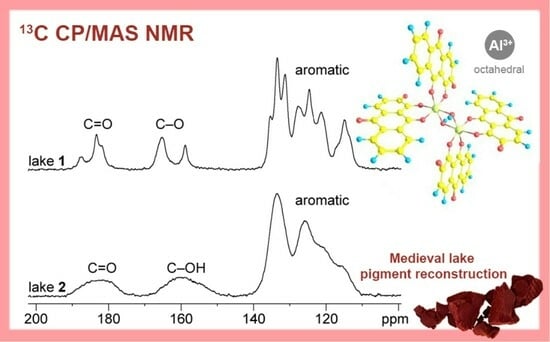
Graphical abstract
Open AccessArticle
Gold Nanoparticles as Monoanion Sensors through Modified Electrophilicity
by
Almudena Martí, Pau Arroyo, Pablo Gaviña, Salvador Gil, Margarita Parra and José A. Sáez
Colorants 2023, 2(4), 591-600; https://doi.org/10.3390/colorants2040030 - 29 Sep 2023
Abstract
►▼
Show Figures
Derived from malachite green, new triaryl-carbonium-ion-functionalized gold nanoparticles have been synthesized for detecting anions. The detection process, and concomitant colour change, is based on charge compensation on the surface of nanoparticles, which triggers their aggregation, resulting in a bathochromic shift of the plasmon
[...] Read more.
Derived from malachite green, new triaryl-carbonium-ion-functionalized gold nanoparticles have been synthesized for detecting anions. The detection process, and concomitant colour change, is based on charge compensation on the surface of nanoparticles, which triggers their aggregation, resulting in a bathochromic shift of the plasmon resonance band. The difference in electrophilicity of the malachite green triaryl ions in solution or on gold nanoparticles makes it possible to distinguish different anions related to their nucleophilic character.
Full article
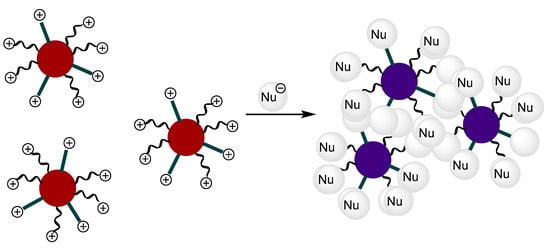
Figure 1
Open AccessArticle
Repurposing the Strontium Ranelate Antiosteoporotic Drug as a New Outstanding Biocompatible Blue Dye
by
Luca M. Sihn, Erick L. Bastos, Marcelo Nakamura, Mayara K. Uchiyama and Henrique E. Toma
Colorants 2023, 2(3), 578-590; https://doi.org/10.3390/colorants2030029 - 13 Sep 2023
Abstract
Blue dyes are relatively uncommon in nature, and a novel dithiophene dye (RanB) is reported in this paper. This dye is derived from an old anti-osteoporotic drug and is a metal ion complexing agent, displaying a planar molecular structure, with two sets of
[...] Read more.
Blue dyes are relatively uncommon in nature, and a novel dithiophene dye (RanB) is reported in this paper. This dye is derived from an old anti-osteoporotic drug and is a metal ion complexing agent, displaying a planar molecular structure, with two sets of carboxylate, isonitrile, thiophene, and iminodiacetate groups. The blue color originates from a strong absorption peak at 648 nm, accompanied by an unusual fluorescence at 555 nm, with higher energy compared to the main absorption band. RanB forms complexes with lanthanoid ions through the iminodiacetate groups and serves as an effective sensitizer for Tb3+ ions, heightening their emission and improving their use as luminescent agents. Its photo-physical properties and the interaction with Tb3+ have been investigated using absorption spectroscopy, steady-state and time-resolved fluorescence spectroscopy, along with computational methods (ZINDO/S and DFT). The RanB toxicity in human umbilical vein endothelial cells has also been tested, showing a lack of toxicity, holding promising prospects for application as a luminescent and coloring agent in pharmaceuticals and food.
Full article
(This article belongs to the Special Issue Feature Papers in Colorant Chemistry)
►▼
Show Figures

Figure 1
Open AccessArticle
Adsorption Process of Methyl Orange Dye onto Zinc Hydroxide Nitrate: Kinetic and Thermodynamic Studies
by
Daiane Amaral de Ramos Nogueira, Tânia Marina Palhano Zanela, Monielly Viomar Machado, Carlos Alberto Policiano Almeida and Rafael Marangoni
Colorants 2023, 2(3), 565-577; https://doi.org/10.3390/colorants2030028 - 06 Sep 2023
Abstract
Zinc hydroxide nitrate (ZHN) was used as an anionic adsorbent for the removal of methyl orange (MO) dye from aqueous solutions. ZHN was characterized via X-ray diffraction (XRD) and infrared spectroscopy (FTIR) techniques. Investigations were carried out to see how the adsorption of
[...] Read more.
Zinc hydroxide nitrate (ZHN) was used as an anionic adsorbent for the removal of methyl orange (MO) dye from aqueous solutions. ZHN was characterized via X-ray diffraction (XRD) and infrared spectroscopy (FTIR) techniques. Investigations were carried out to see how the adsorption of MO was affected by factors such as initial MO concentration, contact time and temperature. Adsorption isotherms were analyzed using the Langmuir and Freundlich equations, with the first one being the better result for the equilibrium data. Adsorption kinetics was studied through applying pseudo-first and pseudo-second-order kinetic models, and the experimental data were better fitted to the pseudo-second-order model. The activation energy was determined using the Arrhenius equation to be 105.45 kJ mol−1, revealing the chemical nature of the adsorption process. The thermodynamic parameters were also determined, showing the adsorption of MO onto ZHN to be a non-spontaneous and exothermic process. The experimental results showed ZHN as a potential adsorbent with adsorption capacity for removing anionic dyes from water medium.
Full article
(This article belongs to the Special Issue Feature Papers in Colorant Chemistry)
►▼
Show Figures

Figure 1
Open AccessArticle
Enhanced Dyeing of Polypropylene Using Fluorine–Oxygen Gas Mixtures
by
Masanari Namie, Jae-Ho Kim and Susumu Yonezawa
Colorants 2023, 2(3), 552-564; https://doi.org/10.3390/colorants2030027 - 31 Aug 2023
Abstract
Surface fluorination with pure F2 gas can easily make the surface on PP (polypropylene) hydrophobic, and it causes limited dyeability, as reported in a previous paper. In this study, to produce a more hydrophilic surface, surface fluorination of PP was performed at
[...] Read more.
Surface fluorination with pure F2 gas can easily make the surface on PP (polypropylene) hydrophobic, and it causes limited dyeability, as reported in a previous paper. In this study, to produce a more hydrophilic surface, surface fluorination of PP was performed at 25 °C, total gas pressure of 13.3 kPa, and reaction time of 1 h using F2 and O2 mixtures with different proportions of F2 gas. The surface roughness of the fluorinated PP samples was about 1.5 times higher than that of the untreated sample (5 nm). Fourier-transform infrared spectroscopy and X-ray photoelectron spectroscopy (XPS) results showed that the PP-derived bonds (-C-C- and -CHx) decreased because they were converted into polar groups (-C–O, -CHF-, and -CFx), which increased the surface electronegativity of the PP. The variation in the F2 gas proportion in the gas mixture significantly affected the hydrophilicity and surface composition of the PP. At F2 gas proportions of <70%, the hydrophilicity of the fluorinated PP samples was increased. Notably, the hydrophilic and negatively charged PP surface enhanced the dyeing of the polymer with basic methylene blue (MB). In contrast, at F2 gas proportions of >90%, the PP surface became hydrophobic owing to increased numbers of hydrophobic -CF3 bonds. Thus, enhanced PP dyeing can be controlled based on the composition of the F2 and O2 gas mixture.
Full article
(This article belongs to the Special Issue Feature Papers in Colorant Chemistry)
►▼
Show Figures
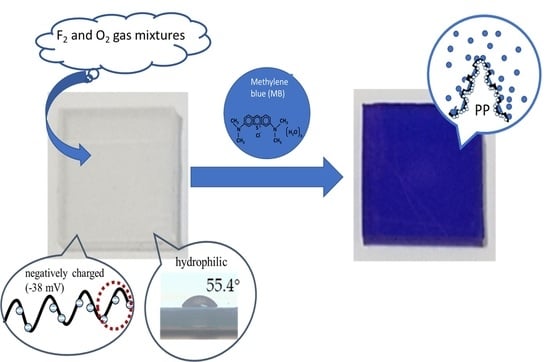
Graphical abstract
Open AccessArticle
Tiles from Aosta: A Peculiar Glaze Roof Covering
by
Eleonora Balliana, Eugénie Marie Claudine Caveri, Laura Falchi and Elisabetta Zendri
Colorants 2023, 2(3), 533-551; https://doi.org/10.3390/colorants2030026 - 14 Aug 2023
Cited by 1
Abstract
►▼
Show Figures
The 18th century roof tiles from the “Casa delle vigne”, located in the Aosta region (north-east Italy), were investigated as an example of a peculiar historical roof covering: ceramic tiles with a lead-based glaze finishing to waterproof them are used to create colourful
[...] Read more.
The 18th century roof tiles from the “Casa delle vigne”, located in the Aosta region (north-east Italy), were investigated as an example of a peculiar historical roof covering: ceramic tiles with a lead-based glaze finishing to waterproof them are used to create colourful patterns. A conservation project proposed the integration of the original tiles with new ones, produced according to traditional methods. Ancient and new tiles were analysed with Fiber Optics Reflectance Spectroscopy, micro-Raman, Fourier Transform Infrared Spectroscopy and X-ray Fluorescence Spectrometry, Thermogravimetry and Differential Scanning Calorimetry for understanding the composition and the production technology of this manufacture. Their resistance to freezing and thawing cycles was then tested, considering their exposure in the severe alpine climate of Aosta. The use of pure clays with low calcium contents, high firing temperature and lead-rich glazes was found in ancient tiles, able to outstand several freezing-thawing cycles without damages. Iron and copper pigments were used in old yellow and green glazes. Zinc-based pigment, low lead and calcium-rich glazes are used in the new ones, which remained mainly coherent to the ceramic body during the freeze-thaw test.
Full article
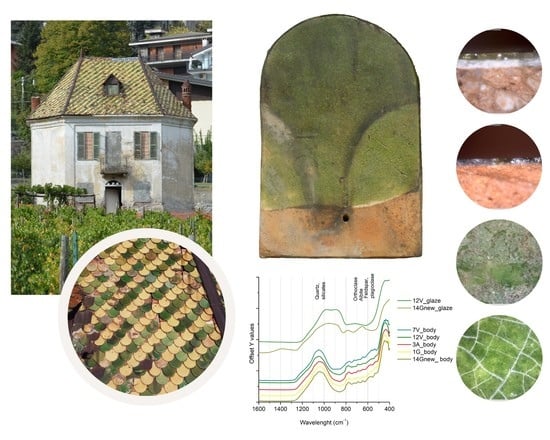
Graphical abstract
Open AccessArticle
Comparative Study of the Synthesis of a Red Ceramic Pigment Using Microwave Heat Treatment
by
Eva Miguel, Guillermo Paulo-Redondo, Juan Bautista Carda Castelló and Isaac Nebot-Díaz
Colorants 2023, 2(3), 518-532; https://doi.org/10.3390/colorants2030025 - 08 Aug 2023
Abstract
►▼
Show Figures
In this study, a new red ceramic pigment has been developed within a perovskite structure, and microwave heat treatments have been applied. Those red ceramic pigments within the YAlO3 system doped with chromium with the nominal composition Y0.98Al0.98Cr
[...] Read more.
In this study, a new red ceramic pigment has been developed within a perovskite structure, and microwave heat treatments have been applied. Those red ceramic pigments within the YAlO3 system doped with chromium with the nominal composition Y0.98Al0.98Cr0.04O3 were synthesized by traditional routes and alternative methods like coprecipitation. Also, heat treatment has been studied comparing a traditional electric and microwave kiln. Different flux agents have been incorporated to improve the synthesis reaction. Prepared pigments have been characterized by X-ray diffraction (XRD) as having a predominant phase of perovskite structure, which is responsible for the red shade, and a minority garnet phase that causes more brown colorations. Studies by Ultraviolet-Visible spectroscopy gave rise to a series of absorption bands that indicate the presence of Cr(III) in the octahedral position corresponding to perovskite and Cr(IV) corresponding to garnet in both the octahedral and tetrahedral positions. The perovskite phase is favored with the use of flux mix, corroborating the UV-visible results and being more pronounced in traditional high temperature thermal treatments. The coprecipitation route has been studied to increase the reactivity of the particles given their nanometric size; however, this reactivity favors a greater appearance of undesirable garnet phases with both types of flux. Scanning Electron Microscopy (SEM) micrographs offer information obtained from the secondary electrons of predominantly cubic crystalline phases with sizes between 1 µm and 2 µm in pigments synthesized via the traditional method and sizes less than 1µm together with the glassy phase in pigments synthesized via coprecipitation. Microwave thermal treatments have been studied, obtaining pigments with a majority structure of perovskite and garnet at lower temperatures and relatively short synthesis times. The feasibility of use in porous single-fired ceramic glazes has been studied, whose chromatic coordinates have been collected using an Ultraviolet-Visible Spectrophotometer based on the CIEL*a*b* system.
Full article
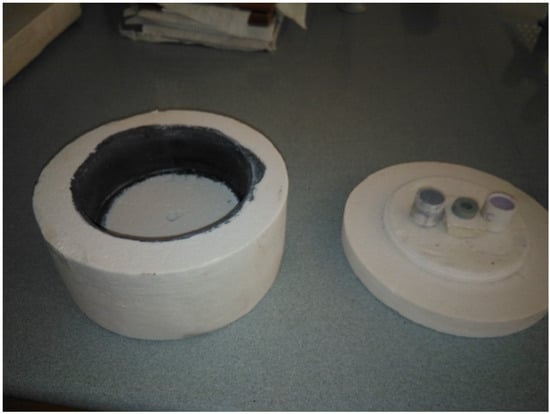
Figure 1
Highly Accessed Articles
Latest Books
E-Mail Alert
News
Topics

Conferences
Special Issues
Special Issue in
Colorants
Feature Papers in Colorant Chemistry
Guest Editor: Anthony HarrimanDeadline: 31 December 2024

